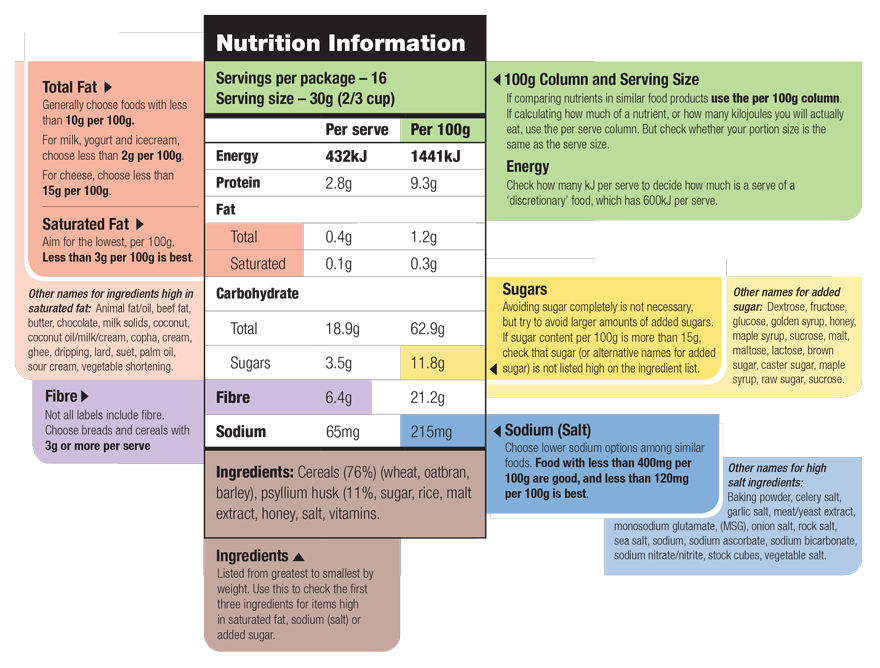- Australian Government Department of Health. How to understand food labels. [Internet] 2015 [updated 2015 July; cited 2016 April 21]; available from: https://www.eatforhealth.gov.au/eating-well/how-understand-food-labels.
Food Standards Australia New Zealand. Ingredients lists and percentage labelling. [Internet] 2015 [updated 2015 Dec; cited 2016 April 21]; available from: http://www.foodstandards.gov.au/consumer/labelling/ingredients/Pages/default.aspx.
Food Standards Australia New Zealand. Allergen labelling. [Internet] 2016 [updated May 2016; cited 2016 June 1]; available from: http://www.foodstandards.gov.au/consumer/foodallergies/Pages/Allergen-labelling.aspx.
The Health Star Rating. Health Star Rating System. [Internet] 2014 [udated Dec 2014; cited 2016 April 21]; available from: http://healthstarrating.gov.au/internet/healthstarrating/publishing.nsf/Content/news-20141210

Food labels: understanding what’s in my food
Food labels can help you take control of your health by providing you with detailed information on what’s in the food you buy. Our handy guide to reading food labels will make it easier for you to make healthy choices for you and your family.
There are four main tools used on food products in New Zealand:
- Nutrition Information Panel (compulsory)
- Ingredients list (compulsory)
- Daily Intake Guide (voluntary)
Health Star Rating (voluntary).
But what do they all mean?
Nutrition Information Panel
Nutrition information panels are the detailed tables that list the energy, protein, fat, saturated fat, carbohydrate, sugar, dietary fibre, sodium and potentially other nutrients contained in the food.
The good thing is they all look the same so once you’ve become familiar with the format, nutrition information panels are a great go-to understand just what’s in a food product. Each nutrition information panel provides a list of nutrients by serve and by 100g (or 100mL if a liquid).
To get you started, here are my tips to the most common questions about nutrition information labels:
- Do you look at amounts per serve or per 100g? As serve sizes vary between products, use the ‘per 100g’ column to compare two similar foods. However, if you want to know the amount of a particular nutrient that food product will give you, then look at the ‘per serve’ column. Remember that the product serve size is intended as a guide but may be different to the amount you choose to eat.
- How do I find a low salt product? If you are looking for foods that are lower in salt, check the sodium line on the nutrition information panel. Aim for foods that have less than 400mg sodium per 100g. Better still, go for low sodium which are less than 120mg per 100g.
- What should I look for when it comes to sugar? It’s not necessary to avoid sugar completely. Instead look for foods that are lower in sugars with less than 10-15g of sugar per 100g, or where sugar is not listed high on the ingredient list. Sugars can be tricky though, as current food labels do not show the difference between natural sugars (like fructose in fruit and lactose in milk) and sugar added to the product as part of manufacturing. So if you are looking at a product that contains ingredients high in natural sugars, like a muesli with fruit, give yourself some leeway and aim for 25g sugar or less per 100g.
- What measure of fat should I be looking at? As a general rule try to aim for products with the lowest amount of saturated fat (less than 3g per 100g). Some food products, like those that contain nuts and seeds will be naturally higher in healthy fats – but don’t worry as these are packed with benefits for your brain, heart and even your waistline.
- What is a good amount of fibre? You can find higher fibre breakfast cereals, breads, crackers, grains and pastas by comparing their fibre per 100g. Generally, products with more than 3g of fibre per serve are a good choice. Also look for products that are made from wholegrains. These good quality carbohydrates are not only higher in fibre than refined grains, but they are also a source of several vitamins, minerals and antioxidants which are important for good health. You can check whether a product contains wholegrains by looking at the ingredients list.
- How much energy should you aim for? A kilojoule is a measure of energy. How many kilojoules you need each day depends on a number of factors including your height, weight, age and your activity levels. If you are concerned about being overweight, then you may need to cut back your energy intake. The best way to do this is to focus on eating mostly whole plant foods including wholegrains, fruits, vegetables, legumes, nuts and seeds. You can also use the label information to help you lose weight by limiting foods high in energy or kilojoules per serve. You can enjoy an occasional snack by choosing products with 600kJ or less per serve.
Ingredients list
All foods sold in Australia and New Zealand must have a list of ingredients on the label. Here are 4 key insights understanding the ingredients lists:
- Order: Ingredients are listed in order from the highest quantities to the least. So, if a product ingredient list has saturated fat, added sugar or sodium (salt) listed as one of the first few ingredients, then it may contain large amounts of these nutrients. Water is also listed unless it's less than 5% of the product.
- Names: Saturated fats, sugars and salt can be hard to spot as they are often listed under different names. Some examples include:
- Saturated fat: animal oil or fat, beef fat, butter fat, milk solids, cream, sour cream, copha, chocolate, tallow, lard, ghee, dripping, suet, coconut oil/fat/milk/cream, palm oil, vegetable shortening.
- Sugar: sucrose, glucose, fructose, lactose, maltose, dextrose, golden syrup, corn syrup, honey, malt, molasses, maple syrup, rice malt syrup, brown sugar, caster sugar, raw sugar.
- Salt: rock salt, sea salt, vegetable salt, celery salt, garlic salt, onion salt, baking soda, baking powder, sodium, sodium ascorbate, sodium bicarbonate, sodium nitrate/nitrite, monosodium glutamate (MSG), stock cubes, yeast extract, meat extract. - Characterising ingredients: An ingredient that characterises a food product or is mentioned on the label - for example almond in almond milk - must list their amount as a percentage. You can see in the ingredients list below that 2.5% of Sanitarium’s Unsweetened Almond Milk is from almonds.
- Unsweetened almond milk ingredients: Filtered water, almonds (2.5%), mineral salts (tricalcium phosphate, sodium bicarbonate), emulsifier (lecithin), natural flavours, salt, vegetable gum (gellan). Contains almonds. May contain other tree nuts. - Allergens: You’ll also notice that ‘almonds’ is in bold and there's a statement, ‘contains almonds’, below the ingredients list. This is because food standard laws require all common food allergens, including peanuts, tree nuts, milk, eggs, sesame seeds, fish, shellfish, soy and wheat, to be clearly declared on the food label.

Health Star Rating
The Health Star Rating system is a government initiative developed in consultation with health organisations, food industry and the public.
It gives you a visual snapshot of the nutrition quality of food products to make it easy for you to compare similar foods and make healthier food choices for you and your family. Basically, the more stars, the healthier the choice. The rating is worked out from an algorithm that takes into account kilojoules or calories plus three 'negative' nutrients - saturated fats, sugars and sodium.
Fruit and vegetables (including some canned and frozen produce) automatically receive 5 Health Stars (the highest rating). Food with higher amounts of salt and total sugars receive lower ratings.

The Health Star Rating is not meant to compare different types of foods. So, for example, it is not meant to compare a yoghurt with a muesli bar, it's designed to compare similar packaged foods within categories and aisles.
Much like nutrition science, the algorithm that determines how many stars to award each product is complicated and not without its flaws. However an independent five year review of the Health Star Rating system release in August 2019 showed that the system is well aligned with dietary guidelines and most shoppers say it is helping them choose healthier foods.
For more on the Health Star Rating and the rating of Sanitarium food products, read our Health Star Rating article or see our products pages for individual products.
Getting to know what’s in the foods you eat is a great way to take charge of your health. Remember, if you have any questions you can always call the manufacturer – their number is usually listed on the food packaging. And, if you have a question for us, just askour dietitians.
Subscribe to Wholicious Living to stay up-to-date with the latest health and nutrition advice.

The latest nutrition advice, plus health and wellness tips delivered to your inbox monthly

